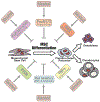Impact of Alcohol on Bone Health, Homeostasis and Fracture repair
- PMID: 33767923
- PMCID: PMC7987106
- DOI: 10.1007/s40139-020-00209-7
Impact of Alcohol on Bone Health, Homeostasis and Fracture repair
Abstract
Purpose of review: Alcohol use continues to rise globally. We review the current literature on the effect of alcohol on bone health, homeostasis and fracture repair to highlight what has been learned in people and animal models of alcohol consumption.
Recent findings: Recently, forkhead box O (FoxO) has been found to be upregulated and activated in mesenchymal stem cells (MSC) exposed to alcohol. FoxO has also been found to modulate Wnt/β-catenin signaling, which is necessary for MSC differentiation. Recent evidence suggests alcohol activates FoxO signaling, which may be dysregulating Wnt/β-catenin signaling in MSCs cultured in alcohol.
Summary: This review highlights the negative health effects learned from people and chronic and episodic binge alcohol consumption animal models. Studies using chronic alcohol exposure or alcohol exposure then bone fracture repair model have explored several different cellular and molecular signaling pathways important for bone homeostasis and fracture repair, and offer potential for future experiments to explore additional signaling pathways that may be dysregulated by alcohol exposure.
Keywords: FoxO; Wnt/β-catenin signaling; alcohol; fracture; mesenchymal stem cells; oxidative stress.
Conflict of interest statement
Conflict of Interest: Jonathan M. Eby, Farah Sharieh, and John J. Callaci declare that they have no conflict of interest.
Figures
Similar articles
-
Ethanol Inhibits Mesenchymal Stem Cell Osteochondral Lineage Differentiation Due in Part to an Activation of Forkhead Box Protein O-Specific Signaling.Alcohol Clin Exp Res. 2020 Jun;44(6):1204-1213. doi: 10.1111/acer.14337. Epub 2020 May 18. Alcohol Clin Exp Res. 2020. PMID: 32304578 Free PMC article.
-
Alcohol-related deficient fracture healing is associated with activation of FoxO transcription factors in mice.J Orthop Res. 2016 Dec;34(12):2106-2115. doi: 10.1002/jor.23235. Epub 2016 Jul 29. J Orthop Res. 2016. PMID: 26998841 Free PMC article.
-
Exogenous activation of Wnt/β-catenin signaling attenuates binge alcohol-induced deficient bone fracture healing.Alcohol Alcohol. 2014 Jul-Aug;49(4):399-408. doi: 10.1093/alcalc/agu006. Epub 2014 Mar 13. Alcohol Alcohol. 2014. PMID: 24627571 Free PMC article.
-
Gone with the Wnts: beta-catenin, T-cell factor, forkhead box O, and oxidative stress in age-dependent diseases of bone, lipid, and glucose metabolism.Mol Endocrinol. 2007 Nov;21(11):2605-14. doi: 10.1210/me.2007-0259. Epub 2007 Jul 10. Mol Endocrinol. 2007. PMID: 17622581 Review.
-
Beta-catenin in the race to fracture repair: in it to Wnt.Nat Clin Pract Rheumatol. 2008 Aug;4(8):413-9. doi: 10.1038/ncprheum0838. Epub 2008 Jun 17. Nat Clin Pract Rheumatol. 2008. PMID: 18560386 Review.
Cited by
-
Vitamin E Improves Cellular and Structural Bone Histomorphometry in an Alcohol-Induced Osteoporosis Rat Model.Pharmaceuticals (Basel). 2024 Dec 20;17(12):1730. doi: 10.3390/ph17121730. Pharmaceuticals (Basel). 2024. PMID: 39770572 Free PMC article.
-
Intermediate and Transitory Inflammation Mediate Proper Alveolar Bone Healing Outcome in Contrast to Extreme Low/High Responses: Evidence from Mice Strains Selected for Distinct Inflammatory Phenotypes.Biology (Basel). 2024 Nov 25;13(12):972. doi: 10.3390/biology13120972. Biology (Basel). 2024. PMID: 39765639 Free PMC article.
-
Nonessential amino acid is not nonessential in geriatric patients: implications for maxillofacial wound healing and bone repair.Maxillofac Plast Reconstr Surg. 2025 May 26;47(1):12. doi: 10.1186/s40902-025-00465-w. Maxillofac Plast Reconstr Surg. 2025. PMID: 40418369 Free PMC article. Review.
-
Osteoporosis and Alveolar Bone Health in Periodontitis Niche: A Predisposing Factors-Centered Review.Cells. 2022 Oct 26;11(21):3380. doi: 10.3390/cells11213380. Cells. 2022. PMID: 36359775 Free PMC article. Review.
-
Alcohol and Periodontal Disease: A Narrative Review.Cureus. 2024 Jun 12;16(6):e62270. doi: 10.7759/cureus.62270. eCollection 2024 Jun. Cureus. 2024. PMID: 39006719 Free PMC article. Review.
References
-
- Manthey J, Shield KD, Rylett M, Hasan OSM, Probst C, Rehm J. Global alcohol exposure between 1990 and 2017 and forecasts until 2030: a modelling study. Lancet (London, England). 2019;393(10190):2493–502. - PubMed
- This study forecasts that the amount of alcohol consumed per adult per year will continue to rise globally.
-
- Johnell O, Kanis JA. An estimate of the worldwide prevalence and disability associated with osteoporotic fractures. Osteoporosis international : a journal established as result of cooperation between the European Foundation for Osteoporosis and the National Osteoporosis Foundation of the USA. 2006;17(12):1726–33. - PubMed
-
- Turner RT, Aloia RC, Segel LD, Hannon KS, Bell NH. Chronic alcohol treatment results in disturbed vitamin D metabolism and skeletal abnormalities in rats. Alcoholism, clinical and experimental research. 1988;12(1):159–62. - PubMed
Grants and funding
LinkOut - more resources
Full Text Sources
Research Materials

